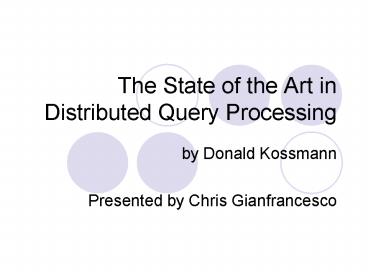The State of the Art in Distributed Query Processing - PowerPoint PPT Presentation
Title:
The State of the Art in Distributed Query Processing
Description:
The State of the Art in Distributed Query Processing. by Donald Kossmann ... Client-server distributed DB models. Heterogeneous distributed DB models ... – PowerPoint PPT presentation
Number of Views:42
Avg rating:3.0/5.0
Title: The State of the Art in Distributed Query Processing
1
The State of the Art in Distributed Query
Processing
- by Donald Kossmann
- Presented by Chris Gianfrancesco
2
Introduction
- Distributed database technology is becoming an
increasingly attractive enhancement to many
database systems - Cost and scalability
- Software integration
- Legacy systems
- New applications
- Market forces
3
Introduction
- Topics covered in this paper
- Basics of distributed query processing
- Client-server distributed DB models
- Heterogeneous distributed DB models
- Data placement techniques
- Other distributed architectures
4
Client-Server Database Systems
- Relationships between distributed nodes take a
client-server form - Client makes requests of the servers, usually
the source of queries - Server responds to client requests, usually the
source of data - System architectures peer-to-peer, strict
client-server, middleware/multitier
5
Architectures Peer-to-Peer
- All nodes are equivalent
- Each can be either a client or server on demand
(can store data and/or make requests) - Ex SHORE system
6
Architectures Strict Client-Server
- Client or server status is pre-defined and can
never change - Clients supply queries, servers supply data
- Most common architecture in commercial DBMSs
7
Architectures Middleware/Multitier
- Multiple levels of client-server interaction
- Nodes act as clients to those below them and
servers to those above - SAP R/3, web servers with DB backends
8
Architectures Evaluation
- Peer-to-Peer
- Simplest setup
- Equal load sharing
- Strict Client-Server
- Specialization
- Administration for servers only
- Middleware/Multitier
- Functionality integration
- Scalability
9
Client-Server Query Processing
- Queries initiated at clients, data stored at
servers - Where do we execute the query?
- Query shipping move the query down to the data
- Data shipping move the data up to the query
- Hybrid shipping combination of both
10
Query Shipping
- SQL query code is sent down to the server
- Server parses and evaluates query, returns result
- Used in DB2, Oracle, MS SQL Server
11
Data Shipping
- Client parses query and requests data from server
- Server provides data, then client executes query
- Data can be cached at client (main memory or disk)
12
Hybrid Shipping
- Mix-and-match data shipping and query shipping
- Query parts can be executed at any level
according to query plan - Data is cached when beneficial
13
Evaluation
- Query Shipping
- Reliant on server performance
- Scales poorly with increasing client load
- Data Shipping
- Good scalability
- High communication costs
- Hybrid
- Potential to outperform other options
- More complex optimizations
14
Hybrid Shipping Observations
- Some observations of optimal performance using
hybrid shipping - Preference to not use a client cache
- If network transfer cost lt client access cost
- Shipping down cached data
- If in main memory execution at server
- Multiple small updates
- Maintain at client and post to server only when
necessary
15
Query Optimization
- Query plans must also specify where the query
pieces are executed - Data shipping all execution done at client
- Query shipping all execution done at server
- Hybrid choice can be made for each operator
- Results display to user is always at client
16
Distributed Query Plans
- Each operator is annotated with a logical site of
execution plans are shareable - client means an operator is executed from the
client where the query is issued - server means
- for scan operators, execute at a location that
has the necessary data - for updates, execute at all locations with the
relevant data
17
Query Optimization Where?
- Should optimization occur at the client or the
server? - At client less load on servers, better
scalability - At server more information about system
statistics, especially server loads - Potential solution primary parsing and query
rewriting at client, further optimization at
server
18
Query Optimization Statistics
- Even when optimization is done at a server, that
server does not usually have full knowledge of
the system - System can either
- Guess the status of other servers less
accuracy, less cost - Ask other servers their status fully accurate,
additional communication costs
19
Query Optimization When?
- Tradeoff of accuracy vs. cost
- Traditional-style optimize once, store plan
- No support for changing DB conditions
- No incurred cost for query execution
- Plan sets optimize for possible scenarios
- Generate a few query plans for diff. conditions
- Choose plans based on runtime statistics
- On-the-fly observe intermediate results
- Re-optimize query if different from expectations
20
Query Optimization Two-Step
- Compile-time generate join order, etc.
- Runtime perform site selection
- Reasonable cost at each end
- Responds well to changing server loads
- Fully utilizes client data caching
21
Two-Step Optimization Downside
- Optimal plan is generated traditional-style
- Site selection is performed
- True optimal plan was missed
- Optimal was missed because first optimization
step was done with no knowledge of the system
22
Query Execution Techniques
- Standard fare row blocking, multithread when
possible - Issues transactions with both updates and
retrieval queries using hybrid shipping - We want to wait to propagate updates for
efficiencys sake - Other option perform query before update and
temporarily pad results
23
- Questions?
- Comments?































